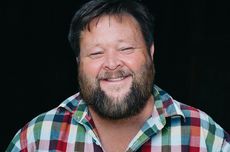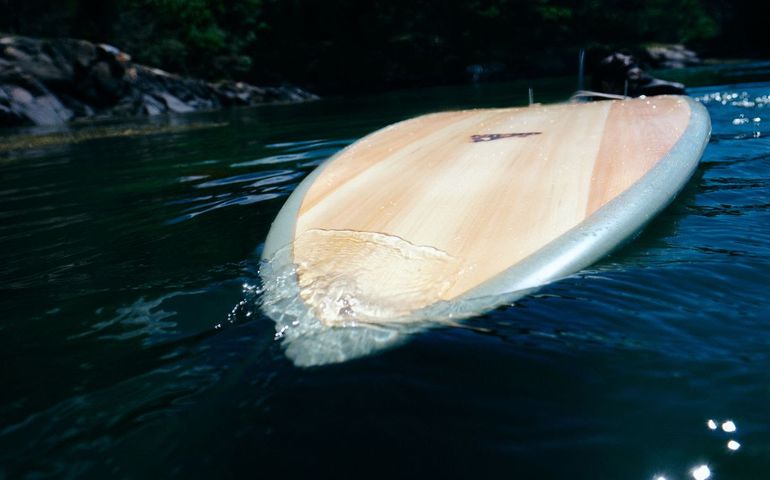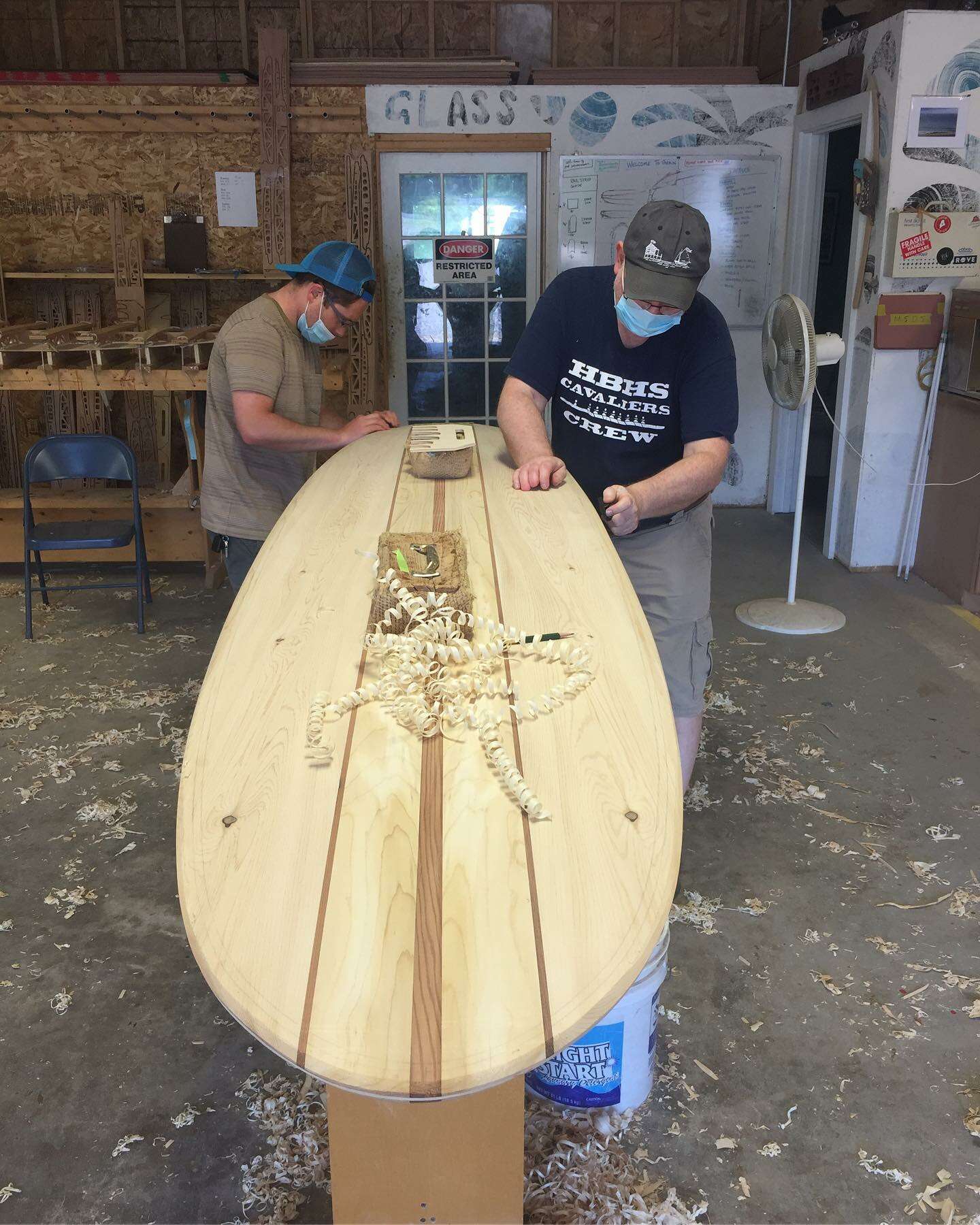
Pandemic gives York surfboard maker time to finalize new hybrid design
 Courtesy / Grain Surfboards
Grain Surfboard’s GreenRail construction installs 100% recycled plastic rails on its all-wood board, a hybrid marketed as a more-affordable model.
Courtesy / Grain Surfboards
Grain Surfboard’s GreenRail construction installs 100% recycled plastic rails on its all-wood board, a hybrid marketed as a more-affordable model.
A few months of sheltering in place was all a York-based manufacturer of surfboards needed to make the final touches on a new type of board.
Grain Surfboards last week unveiled a new design called GreenRail, which combines wood construction with a perimeter "rail" made of 100% recycled plastic bottles. The boards are quicker to build and offered at a lower price than the company’s all-wood boards.
“That outermost rail is where all the shaping happens,” the company’s owner, Mike LaVecchia, told Mainebiz. “It requires a lot of precise milling.”
When created from wood, the complex curvatures required along a surfboard’s perimeter involve 10 or 11 pieces individually shaped and fitted together. And every model design and size requires a different rail configuration.
By contrast, the GreenRail's rail can be made by using solid lengths of lightweight extruded plastic that’s heated and bent along the perimeter, then shaped by hand. The process is far less time-consuming, LaVecchia said. And the innovation can half the price: An all-wood board costs $2,000 to $2,400, compared with about $1,200 for the hybrid model.
Grain has made wooden surfboards since 2005. It also sells kits that include the materials and instructions needed for customers to build their own surfboards. And it typically offers workshops throughout the year, at its shops in York and Amagansett, N.Y., and on the West Coast.
“We had to cancel a lot of workshops" this year, said LaVecchia.
That left plenty of time to tinker with an idea that had been in the works for years: How to incorporate the use of a 100% recyclable plastic called polyethylene terephthalate, or PET, into the board manufacturing process in such a way that would lower the time, and therefore the cost, to build the boards.
“We took the last few months when things were slower as an opportunity to dial it in,” he said.
As it turned out, this is a good time to be in the surfboard business. It appears that folks sheltering at home are trying new things, whether that’s surfing or building a surfboard.
“Surf shops are selling out of boards,” he said. “This is a good time to get this out there. The response has been great. We’ve got a couple of orders already.”
Born and raised in New Jersey, LaVecchia moved to Vermont when he 17 to work for Burton Snowboards.

After 12 years, he obtained a U.S. Coast Guard captain’s license, operated a commercial sailing vessel on Lake Champlain, and explored the East Coast by water from the Caribbean to Maine. In 2001, with his knowledge of vessel operations, and experience working on many wooden boats over the years, he jumped at the opportunity to manage the construction of an 88-foot wooden schooner being built by the Lake Champlain Maritime Museum in Ferrisburgh, Vt.
He also took up surfing during that time. One of his surfing destinations was York, where he moved in 2005. He began adapting his knowledge of wooden boat construction to surfboard design and construction.
“How a surfboard works with your body is different from a boat, but the principles for how it moves through the water are the same,” he explained.
Construction of the schooner involved the use of cedar sourced from Maine. When he began thinking about building surfboards, he realized that using Maine cedar made a lot of sense.
At the time, he said, the industry was dominated by a California company named Clark Foam, which produced surfboard “blanks” out of plastic foam. Surfboard makers "shaped" the foam blanks to their own designs. Since the 1950s, foam and fiberglass had made surfboard manufacturing quicker and cheaper.
“The surf industry came to life,” he said. “Foam was more efficient and cost-effective. All of a sudden, everybody could have a board.”
The art of building wooden boards faded away, he said.
“There were foam shapers in Maine, but no one was building wood boards other than private individuals,” he said.
Soon after LaVecchia started his operation, Clark Foam closed, leaving the door open to surfboards made of other materials.
“People started looking for alternatives,” he said. “That helped put us on the map.”
He had no intention of starting a business. But after building a handful for family and friends, an Associated Press story about the builder appeared in the Honolulu Star-Bulletin and other papers across the nation and orders started coming in.
Today, Grain combines 3D modeling technology with hand-built woodworking techniques and local, sustainable softwoods to build surfboards one at a time.

Wood for its boards and kits are sourced from Maine mills and forests that practice sustainable harvesting. All wood waste from the production of Grain's boards and kits is reduced and recycled. Grain ships surfboards and kits worldwide and hosts week-long workshops.
“Out west, we have a school bus and a trailer that’s basically a mobile workshop, and teach at different venues,” he said.
Before the pandemic, one of this employees would spend half the year teaching classes along the West Coast, hosted by places like Patagonia and colleges, to take advantage of the large West Coast surfboard market. At the York shop, Grain typically holds a workshop every month with up to eight people. It offers private classes: in February, it hosted a student who flew from Australia to take a one-on-one class for a week.
LaVecchia and his team typically build up to 40 completed boards per year on top of producing kits and paper plans.
Kit sales have been doing well during the pandemic.
“People are looking for something to do at home,” he said.
With nine full- and part-time employees, the business has remained the same size “for quite a while,” he said.
“We’re less focused on growing the business and more focused on doing what we love and supporting our staff, making sure we’re here and healthy and have a good lifestyle,” he said.
The idea for the GreenRail came about from the company’s experiments with design and construction processes and materials. Over the years, the team has tinkered with samples of recycled plastic to see how it might be incorporated.
“Every few months we cut a few pieces and tried it in different ways,” he said.
From the manufacturing standpoint, the most time-consuming part of building a board is the perimeter — the outermost inch and an half of board that connects with the waves and affects the way the board performs. The rail’s shape continually changes along the length of the board.
The team realized it could use the PET material to reduce labor and therefore the price point in order to gain a wider customer base, he said.
Marketing includes a newsletter to the company’s email list of about 15,000 people, social media, news releases and calls to others in the industry.
For a couple of years, prototyping was done with free samples. The company recently invested $6,000 to $7,000 to buy the plastic it needed to build its first boards on speculation.
“With a quieter shop, we’re focused on building as many of the GreenRail boards as we can,” he said.










0 Comments